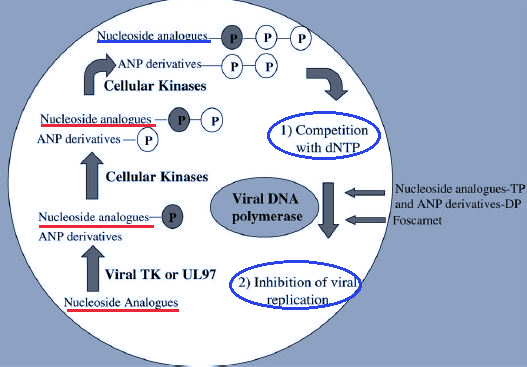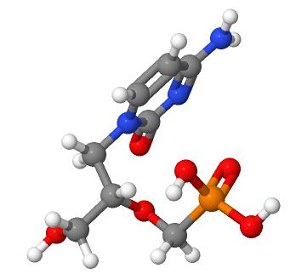|
|
|
Medical Pharmacology Chapter 36: Antiviral Drugs
Antiviral Drugs
Acyclovir and Related Drugs continued:
Acyclovir and its derivatives represent first-line drugs both for HSV infection prophylaxis as well as for treatment.4
These agents are "prodrugs" and require several phosphorylation steps to form the active compound.
The first phosphorylation step is dependent on a virus-encoded thymidine kinase (TK).
Host cellular GMP kinase and nucleoside diphosphate kinase catalyze the two additional phosphorylation steps.
![]() Long-term
administration of acyclovir and related agents can lead to the
development of resistance, particularly in immunocompromised patients.
4
Long-term
administration of acyclovir and related agents can lead to the
development of resistance, particularly in immunocompromised patients.
4
The likelihood of the development of acyclovir-resistance in herpes simplex virus isolates (HSV isolates) is quite different between immunocompetent and immunocompromised individuals.
The most important factor may be that host responses are impaired and less pathogenic viral strains that normally would not survive in the context of a normal host response may continue to replicate.
The prevalence of acyclovir resistance in HSV in immunocompetent patients ranges from about 0.3% to 0.7%.
By contrast, the prevalence of HSV infections with diminished acyclovir susceptibility in immunocompromised patients is about 10 times higher, 3.5% to about 10%.
Taking into account the mechanism of acyclovir-antiviral action, viral mutations that confer resistance to acyclovir have been described in the UL23 gene which codes for the viral thymidine kinase (TK) which catalyzes the initial acyclovir phosphorylation step.4
Another mutation sites that confers resistance is associated with the UL30 gene which codes for the DNA polymerase enzyme.4
HSV depends on a functional DNA polymerase to replicate; whereas, an intact viral thymidine kinase may be dispensable in some mammalian tissues.
Accordingly, a viable acyclovir-resistant virus is more likely found as a result of a mutation in the UL23 gene compared to UL30 gene mutations.
Several phenotypes for acyclovir-resistance thymidine kinase (TK) mutants have been described.
These include TK-negative mutants which lack thymidine kinase catalytic activity, TK-low-producer mutants which results in decreased enzymatic activity nad TK-altered isolates show substrate-specific mutations in that they phosphorylate thymidine but not acyclovir.
Most (95%) of acyclovir-resistant HSV clinical isolates are either TK-negative or TK-low-producer mutants.4
 |
|
Acyclic Nucleotide Phosphonates, e.g. Cidofovir (Vistide)
The drugs considered to this point are "classical" acyclic nucleoside analogues.
Examples of these drugs include acyclovir, ganciclovir and penciclovir.
Furthermore, other agents not yet discussed are similar in requiring an initial phosphorylation step.
Examples of these drugs include dideoxynucleoside analogues such as zidovudine (AZT) and lamivudine (3TC).
Therefore, in cells in which the initial nucleoside kinase exhibits reduced activity or is even not present the nucleoside analogues are inactive.
By contrast, another class of drugs are phosphonate derivatives, the acyclic nucleoside phosphonate's or ANPs.
ANPs are converted by nucleotide kinase (GMP kinase or AMP kinase) to a monophosphate form, an analog of diphosphate and then to the triphosphate analog by a nucleoside diphosphate kinase.
The active form is represented by the triphosphate (ANPpp) analogues.
Cidofovir (Vistide) is one example.
|
|
 |
|
|
|
|
|
|
|
|
|
|
|
Cidofovir (Vistide) inhibits viral DNA synthesis.
|
|
This inhibition occurs by terminating viral DNA chain elongation.6
In the case of cidofovir, two consecutive ("tandem") incorporations are required to terminate DNA in an efficient way in accord with the mechanism demonstrated for cytomegaloviral inhibition.6
Other acyclic phosphonate-type antiviral drugs exhibit slightly different mechanisms.6
For example, adefovir (Preveon) acts by incorporating one molecule at the 3'-end of the growing DNA chain with this addition sufficient to terminate elongation.
This requirement is also noted for tenofovir.6
As cidofovir is a phosphonate, phosphorylation proceeds only by cellular, not viral enzymes.1
![]() Accordingly,
cidofovir can inhibit acyclovir-resistant thymidine kinase (TK)
or thymidine kinase-modified herpes simplex virus (HSV) or
varicella-zoster virus (VZV) strains.1
Accordingly,
cidofovir can inhibit acyclovir-resistant thymidine kinase (TK)
or thymidine kinase-modified herpes simplex virus (HSV) or
varicella-zoster virus (VZV) strains.1
Additionally, ganciclovir-resistant cytomegalovirus (CMV) strains exhibiting UL97 mutations (not strains with DNA polymerase mutations) would likely be sensitive to cidofovir.
Cidofovir is also effective in some foscarnet-resistant CMV isolates.
Cidofovir in combination with ganciclovir or foscarnet inhibits CMV replication in a synergistic manner.1
![]() The
molecular target for cidofovir is the viral DNA-dependent DNA
polymerase.6
The
molecular target for cidofovir is the viral DNA-dependent DNA
polymerase.6
For tenofovir and adefovir the molecular target in the human immunodeficiency virus (HIV) or hepatitis B is the virus RNA-dependent DNA polymerase (reverse transcriptase)6
|
|
|
This Web-based pharmacology and disease-based integrated teaching site is based on reference materials, that are believed reliable and consistent with standards accepted at the time of development. Possibility of human error and on-going research and development in medical sciences do not allow assurance that the information contained herein is in every respect accurate or complete. Users should confirm the information contained herein with other sources. This site should only be considered as a teaching aid for undergraduate and graduate biomedical education and is intended only as a teaching site. Information contained here should not be used for patient management and should not be used as a substitute for consultation with practicing medical professionals. Users of this website should check the product information sheet included in the package of any drug they plan to administer to be certain that the information contained in this site is accurate and that changes have not been made in the recommended dose or in the contraindications for administration. Advertisements that appear on this site are not reviewed for content accuracy and it is the responsibility of users of this website to make individual assessments concerning this information. Medical or other information thus obtained should not be used as a substitute for consultation with practicing medical or scientific or other professionals. |